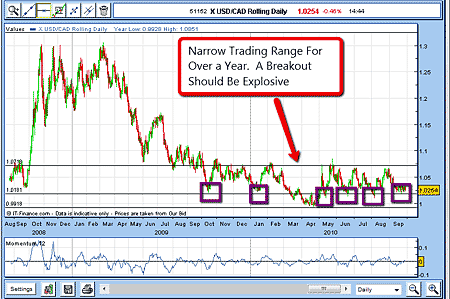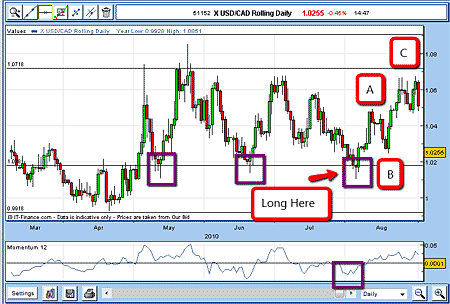How to avoid 'whiplash' and trade range-bound markets
'Whiplash' describes getting caught out when the market moves one way, then the other, frustrating your trades. But here's a strategy to minimise the chance of this happening.
As a trader, you research a market, decide there is a big move ahead, and pull the trigger. You are then in the lap of the gods.
Sometimes, the market follows your script; sometimes it doesn't, and goes nowhere. It meanders around, driving you crazy in the process, and then your trade gets stopped out.
Maybe you get a little shaken by this, and decide you're on the wrong side of the trade. So you take the opposite trade. But the market fails to follow through, and stops you out yet again.
MoneyWeek
Subscribe to MoneyWeek today and get your first six magazine issues absolutely FREE

Sign up to Money Morning
Don't miss the latest investment and personal finances news, market analysis, plus money-saving tips with our free twice-daily newsletter
Don't miss the latest investment and personal finances news, market analysis, plus money-saving tips with our free twice-daily newsletter
Welcome to the frustrating world of the 'whiplash'. This term describes perfectly the picture a whip, when cracked, moves one way, then the other, but is always painful in the end! If you recognise the scenario above, don't worry we've all been there. But over the years, I have developed a strategy to minimise the chance of this happening.
How to avoid whiplash
My first port of call when researching a market is to look at the daily chart and see if some Elliott waves just stand out. Often they do, and I then go to a shorter timeframe to dig deeper.
But if there is no obvious pattern, the market is probably in a trading range that will continue.
A great example from earlier this year is the US dollar (USD) vs the Canadian dollar (CAD). The Canadian currency has a very large following. It's one of the 'commodity currencies', since Canada is a major commodity producer.
Since commodities have been in a large bull market this year, CAD should have been very strong. Yet even although the US dollar has been exceedingly weak since June 2010, the exchange rate went nowhere over the summer. In fact, right up to the end of September it was trading in a clearly-defined zone as shown on the chart:

In June, when the US dollar peaked, the USD/CAD fell back to previous support just below 1.02, and then began a three-wave rally to the upper edge of the trading zone above 1.06, where it met stiff resistance and fell back down towards the lower support line, again in a clear three-wave pattern.
I noted that all rallies and dips between the lines took place in clear three-wave (A-B-C) patterns. According to Elliott wave principles, this is classic consolidation behaviour a range-bound market. So once I spotted that, I decided to go long on 6 August at the bottom of the trading range, as I believed there was a good chance the support would hold.
Also, momentum (the blue line below the main chart) was in 'oversold' territory, indicating that the down move was probably exhausted.
6 August Long £1 USD/CAD @ 1.0225.
Protective stop @ 1.0100.
Risk £125 (2.5% of £5,000 account balance)

My target was near the upper resistance area at the upper zone line (see chart above) and I was looking for a clear three-wave move, as all the others had been. Over the next few days, the market did indeed bounce up from the support zone, and I was able to move my stop to break-even, following my break-even rule.
As that level was being approached, I placed a resting limit sell order at 1.0630, just beneath the previous tops at the 1.0670 level.
On 24 August, I was filled and breathed a sigh of relief.
August 24 Sold £1 US/Can @ 1.0630.
Profit £405 (Risk £125)
That was nice, but since the market was back up to the upper line, and momentum was getting 'overbought', should I be looking to short the market for a possible ride down the escalator? Hmm
Get the latest financial news, insights and expert analysis from our award-winning MoneyWeek team, to help you understand what really matters when it comes to your finances.
John is is a British-born lapsed PhD physicist, who previously worked for Nasa on the Mars exploration team. He is a former commodity trading advisor with the US Commodities Futures Trading Commission, and worked in a boutique futures house in California in the 1980s.
He was a partner in one of the first futures newsletter advisory services, based in Washington DC, specialising in pork bellies and currencies. John is primarily a chart-reading trader, having cut his trading teeth in the days before PCs.
As well as his work in the financial world, he has launched, run and sold several 'real' businesses producing 'real' products.
-
 Investors will reap long-term rewards from UK equities
Investors will reap long-term rewards from UK equitiesOpinion Nick Train, portfolio manager, Finsbury Growth & Income Trust, highlights three UK equities where he’d put his money
-
 The graphene revolution is progressing slowly but surely
The graphene revolution is progressing slowly but surelyEnthusiasts thought the discovery that graphene, a form of carbon, could be extracted from graphite would change the world. They might've been early, not wrong.